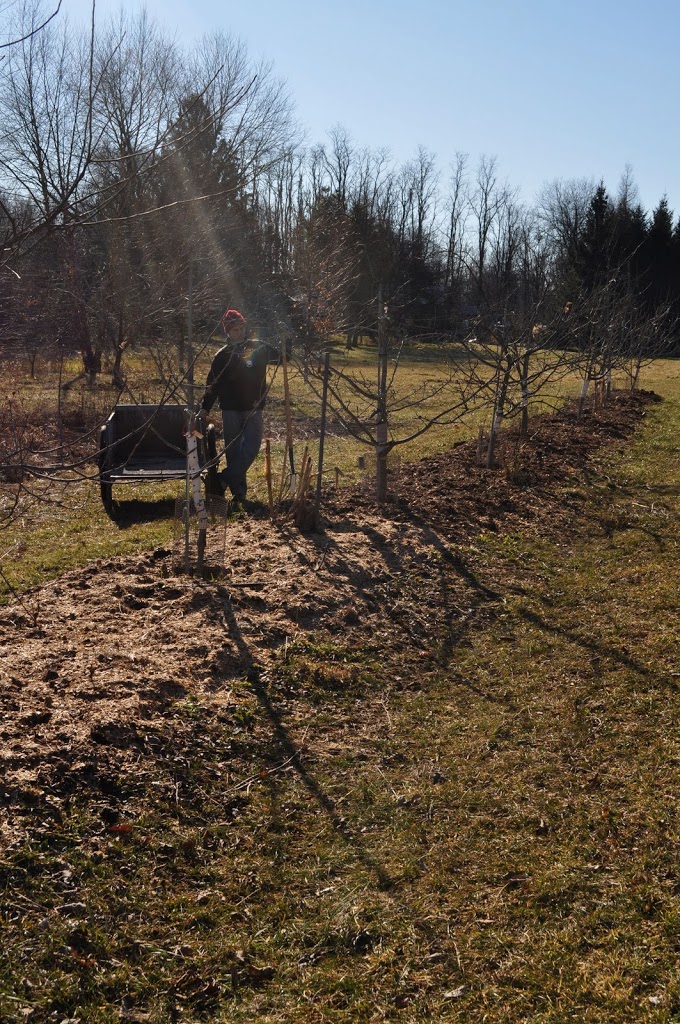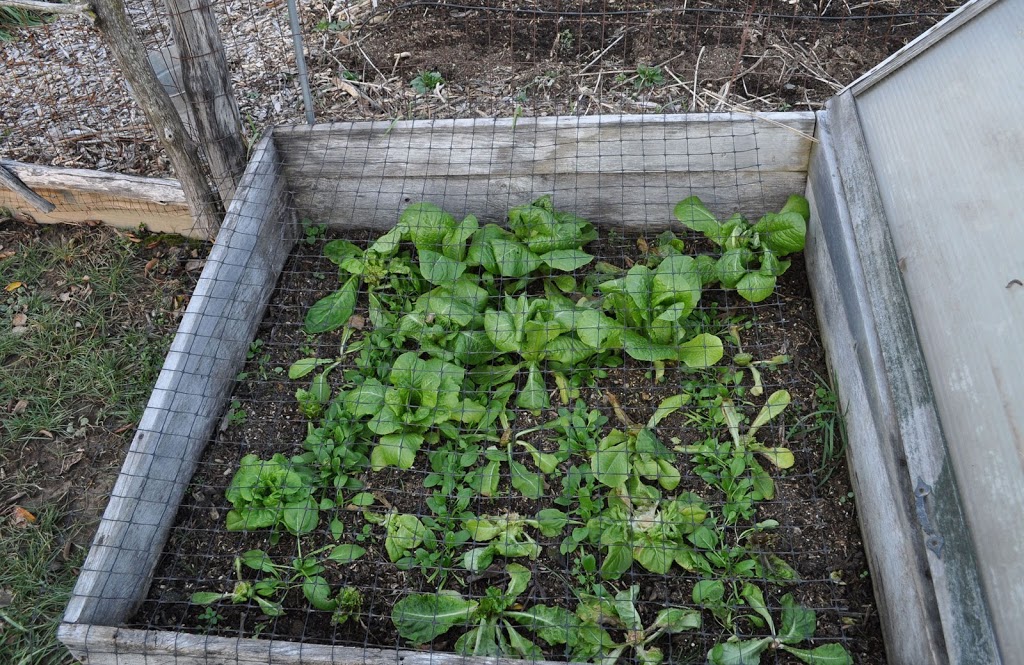KEEPING MULCH SIMPLE
Dryish and cold, but not frigid, weather: What else is there to do outdoors, gardenwise, but mulch? (Pruning is best left until after the coldest nights of winter have passed, in late February.) Arborists dumped a large pile of wood chips near my neighbor’s garden and he spread all he could in paths and among berry bushes. What’s left is for me.
Not that I hadn’t myself been spreading mulches all through autumn. Compost went on the vegetable beds, wood chips from my own pile (long gone) beneath my berry bushes and around trees, and horse manure mixed with wood shavings beneath the young row of dwarf apple trees.
Mulch is one of those things in life that you can’t have too much of — if you’re a gardener — so I forked the neighbor’s wood chips into my garden cart and hauled five loads over to my apple trees. The apples would be thankful because, as dwarf trees, they need the best possible soil conditions to keep them growing vigorously, vigorously for dwarfs, that is. Also, manure left on top of the ground in winter, especially manure left exposed to the elements, loses some its goodness as its nitrogen evaporates into thin air. Barring snow, not in the offing as of this writing, the wood chips blanket should minimize that loss.
One other benefit of wood chips are that they look nice. They are dark brown, similar to dirt. Unfortunately, the five cart loads was enough to cover only half of the 150 foot row of apples.
————————————–
I like to get on top of any gardening fad as it comes down the pike, although not necessarily to embrace it. One such fad concerns wood chips, not any old wood chips, but “ramial wood chips,” defined as wood chips made from wood no larger than about 3 inches in diameter.
Is there anything magical about ramial wood chips? These chips are surely better than the chunks of bark or wood mulch, some of it dyed red, sold in plastic bags. Ramial wood chips are cheaper, often free and, having smaller pieces, are more biologically active and better at smothering weeds and maintaining soil moisture than chunks. As compared with local, arborists’ chips that would include chips from from larger diameter wood, ramial wood chips, with their higher proportion of bark and living tissue, would be higher in nutrients.
Still, no reason to snub your nose at any and all wood chips (except for those bagged chunks). When used as mulch, a dynamic interface of decomposition develops where the bottom layer of raw chips meets the top layer of decomposed material. Nutrients are concentrated as microbes gobble up the materials and carbon, hydrogen, and oxygen are breathed away as carbon dioxide and water, so the nutritional advantage of ramial wood chips over run-of-the-mill arborists’ chips is lost.
Some people tout ramial wood chips as promoting beneficial fungi in soils, allegedly to the liking of trees — such as apples — naturally found in forests. But when any old kind of wood chips — any organic materials, for that matter — is laid atop the ground, it is worked upon by a naturally orchestrated sequence of microorganisms, fungi included. Yes, fungi are promoted, but so are bacteria and other organisms, standing ready to gobble up the more readily accessible foodstuffs after fungi have finished with them. No need to use special kinds of woods chips for special effect.
So, enough about ramial wood chips! Wood chips of every stripe are available free or cheap as a waste product. They’re all beneficial. I use any and all that are offered, and that’s what went on the ground beneath my apple trees.
To quote Thoreau: “Simplify, simplify.”







What, no snow? I am inspired as I have mulch to spread and time now. Today, gardening chores inspired by Lee. Thanks!
I agree that mulch can be a good thing, but I don’t recommend spreading large amounts of *leaf mulch*as I did a few years ago. It was an open invitation for voles to move in. I’m still dealing with the problem. Trapping helped some, but the when our neighbor got an outdoor cat, we noticed a definite decrease in the vole population.
What’s the best way to find free wood chips?
Do you distinguish between hardwood and softwood chips? I have heard that its important to stick with hardwood. Most often, I can get a pile of wood chips from the county but there is no way to know what percentage is hardwood or softwood. Would it still be OK to use this around my fruit trees and berry bushes? thanks, Maryam
No need to complicate things. Any and all wood chips are beneficial. Go ahead and use the wood chips from the county with abandon. Well, not with abandon, but up to about 3″ deep. Don’t worry about hardwood vs softwood or the species or the size branches that were chipped. (Some people recommend, without any good supporting research or experience, only using chips from branches less than a couple of inches; ignore such recommendations!)
Actually, there is some good research on the value of chips from smaller branches and twigs: see http://www.dirtdoctor.com/view_org_research.php?id=69
In particular:
“The C/N ratio for ramial wood ranges from 30/1 to 170/1 while for stemwood the C/N ratio ranges from 400/1 to 750/1. Branches under 7 cm in diameter, without their leaves, are the best choice for shredding. In the North-American species, essential plant nutrients (N, P, K, Ca, Mg) increase when branch diameter decreases. These concentrations reach a minimum in branches over 7 cm in diameter, so branches having less than 7 cm in diameter contain 75% fertilizing nutrients. The bigger the branches the less digestible they become.”
Having read the original paper from Laval University, I am familiar with the arguments favoring use of ramial wood chips. Yes, they are higher in nutrients than chips from larger branches, especially with respect to N. But I like to feed and mulch my plants with a variety of organic “waste” products, thus providing a spectrum of nutrients, so am not overly dependent on only wood chips. Furthermore, the N in larger branches is eventually released into the soil, admittedly more slowly than from smaller chips but there’s no rush to digest them except initially in poor soil.
Wood chips are a readily available waste product that’s a valuable garden resource. Unless you make your own chips, you can’t be bothering arborists telling them you want only ramial wood chips. It’s all good, very good.
That Laval University paper on wood chips hardly proves their benefit. I considered mostly a promo for racial wood chips. I take issue also with their recommendation against the inclusion of chips with leaves, allegedly because that will promote undesirable bacterial growth. Although this concept gets a lot of press, I have yet to see proof that manipulation of the amounts of bacteria and fungi in a soil actually having a direct affect on plant health.
It really helped when you said that ramial wood chips are better than bark or wood mulch while being cheap as well. I will suggest this to my husband if he plans to get mulch products for the lawn this weekend. Also, it will be perfect for this limited budget at the moment.
I wrote that ramial wood chips are NOT better than run of the mill arborist wood chips.